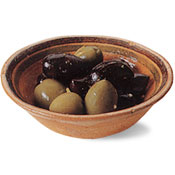|
|
Cuisine Glossary
| You have reached our International Cuisines and information on all aspects of a countries cuisine.
We will try to explain the culture, significant influences, climate, and other factors that have come together to create a distinct style. For example: Spanish, Mexican or Japanese. |
Spanish Cuisine
 |
Food in Spain is taken very seriously. Dining is an indispensable ingredient in the country's ebullient social lifestyle. Meals are long and leisurely, providing an opportunity to enjoy good company, freshly prepared dishes, and fine wines, such as the world-famous Riojas. Spanish cuisine is based on the healthy Mediterranean diet. Prized Spanish olive oil, garlic, fresh daily produce and wine are the staples. The striking cultural contrasts between España Regional are reflected in the tremendous variety of cooking styles. The central plateau of Castilla is known for its delicious roasts: lamb, kid, suckling pig, and game such as partidge. Try the garlic soup, hearty beef stews and famous Manchego cheeses. Valdepeñas and Ribera del Duego make exceptional red wines. Catalanes (Cataluña) are marvelously bold cooks, combining game or poultry with seafood, and savory meats with sweet sauces and dried fruits and nuts. Vasco, País Vasco cooking is considered the most sophisticated and innovative in Spain. The city of San Sebastián (País Vasco) is exemplary, with tremendous concentration of five-fork restaurants serving some of the finest food in Europe Traditional cuisine is at its best in fish and shellfish. The northwestern region of Galicia is Spain's source for a wide variety of fresh shellfish, from scallops and mussels to more exotic delicacies such as barnacles and spider crab. Try the octopus, accompanied by the famed Albariño and Ribeiro wines. Andalusía is home to the refreshing gazpacho and garlic-almond soup, delicious olives, and world-famous Sherries. The rice fields of Valencia gave birth to the paella as well as a wide variety of delicious rice dishes. Spain's greatest contribution to gastronomy may well be the tapa. These little portions of regional specialties are served in restaurants and bars throughout Spain and are generally accompanied by wine, beer or sangria. Source: HungryMonster Writers |




